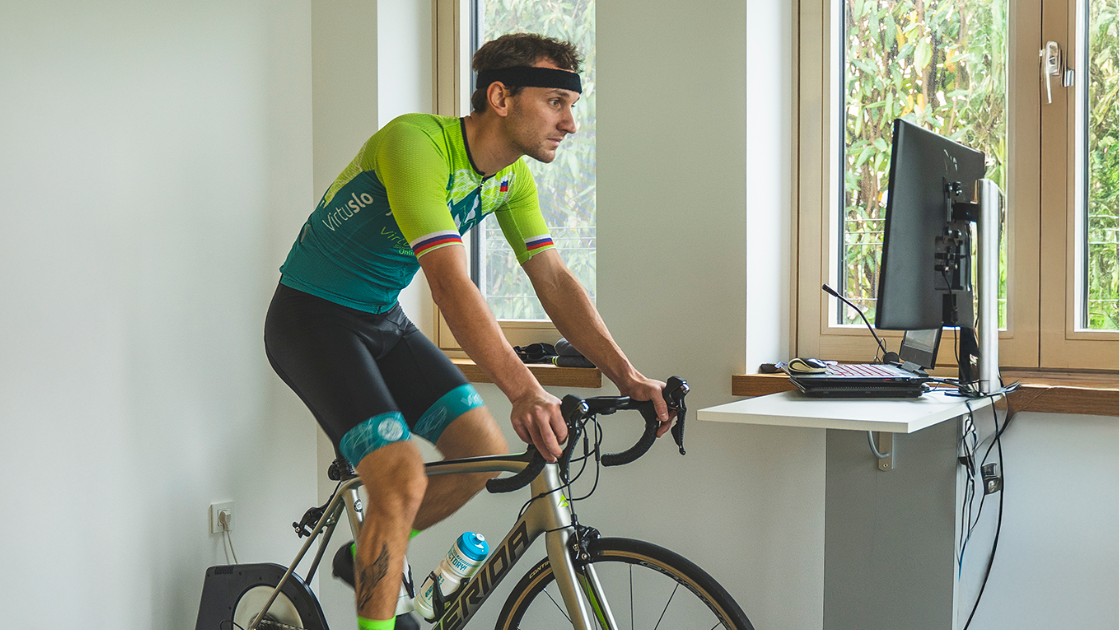During the Nduranz Indoor Cycling podcast, Dr. Tim Podlogar and Alex Rhodes sat down with elite eSports cyclist Thomas Perren. Alex, who primarily races MTB, admitted that heat gets to him when training indoors.
He’s not alone. Excessive sweating is a common problem. If you’ve watched videos of cyclists riding on turbo trainers, you’ve likely seen them drenched, with sweat puddles collecting beneath their bikes.
But here's the thing: Sweating like crazy may be common, but it isn't okay: It's a sign of poor heat management.
Heat Management Isn't Just about Comfort
As Thomas explained, in team time trials, poor heat management can lead to power drop-offs of up to 20%. That’s a significant performance loss. By improving his heat management, he was able to improve his performance.
Your Body Is a Giant Radiator
As Dr. Tim explains, the human body generates a tremendous amount of heat during exercise. This is particularly true for indoor cycling races, which are often relatively short but require high power outputs.
Only about 20% of the energy your body produces goes into moving the pedals; the remaining 80% becomes heat.
To cool itself, your body sweats. As sweat evaporates from your skin, it carries heat away in a process called evaporative heat loss. However, for this cooling mechanism to work effectively, the environment must allow sweat to evaporate efficiently.
Fans Are Helpful—But Not Enough

When cycling outdoors, moving through the air creates a wind effect. For instance, if you’re riding at 30 km/h, it feels like a 30 km/h breeze is hitting you.
Airflow removes the humid, sweat-saturated air from your skin and replaces it with drier air. This allows more sweat to evaporate, improving your body’s evaporative cooling system.
Indoor cyclists try to replicate this outdoor wind effect with fans. While fans can improve cooling, many riders find that even with multiple fans running, it doesn’t feel the same as cycling outdoors.
The main reason? Humidity.
The Role of Humidity in Heat Management
When you’re cycling indoors, your sweat doesn’t simply disappear. As it evaporates, it increases the humidity in the room. The smaller the room, the faster humidity levels will increase.
Keep in mind that sweat rates can exceed one liter per hour during intense sessions, so the air in your room can quickly become saturated with moisture.
As humidity rises, air’s ability to absorb more vapor decreases. Even with fans on full blast, the sweat on your body simply won’t evaporate efficiently.
Yet, your body keeps producing sweat--and it starts dripping off of you. Dr. Tim said, “All this sweat is basically used for nothing.”
At humidity levels of 70% to 80%, evaporative cooling becomes ineffective. Your body keeps sweating in an attempt to cool down, but without proper evaporation, you don’t cool down.
Tim's Take:
“If the humidity goes above 70%, I’m cooked. That’s when I just don’t work anymore.”
 Even though we are talking about indoor cycling, the same heat management principles apply to other types of indoor workout sessions.
Even though we are talking about indoor cycling, the same heat management principles apply to other types of indoor workout sessions.Humidity Problems Are Worse in Winter
You might think turning down the temperature would help with heat management, but cold temperatures make humidity worse. Cool air holds less moisture than warm air. For example, air at 30°C can hold about three times as much water vapor as air at 10°C.
As a result, in a cold room, the relative humidity will rise quickly as you sweat. This can make it feel oppressively humid, and your sweat won’t be able to evaporate efficiently, leaving you soaked and overheating.
Strategies to Improve Heat Management When Training Indoors
To manage heat effectively and improve your performance during indoor cycling, consider the following:
- Invest in High-Quality Fans: Use fans that provide strong airflow and position them strategically to target your upper body, where most heat is generated.
- Control Room Humidity: Use a dehumidifier to keep humidity levels below 70%, ensuring sweat can evaporate efficiently.
- Ventilate Your Space: Open windows or doors to create better airflow and allow humid air to escape. If possible, train in a larger room where humidity levels rise more slowly.
- Hydrate Properly: Replace fluids and salts lost through sweat by drinking a mix of water and electrolytes during your session. This helps prevent dehydration and supports your body’s cooling mechanisms.
- Wear Breathable Clothing: Choose lightweight, moisture-wicking fabrics that allow sweat to evaporate more easily.
- Acclimate to Heat: Gradually increase your exposure to heat during training to help your body adapt. For example, Thomas will sometimes turn off the fans for the last 30-60 minutes of his session and let the room get really hot.
- Use Ice Packs: Thomas also uses ice packs. He will hold one against glaborous skin—hairless areas like your palms where heat transfer is particularly effective. This provides quick relief and helps lower body temperature during intense sessions.
Want to hear the entire discussion?
Listen to the podcast episode below. Or see the other Nduranz podcast episodes for more pro tips.

